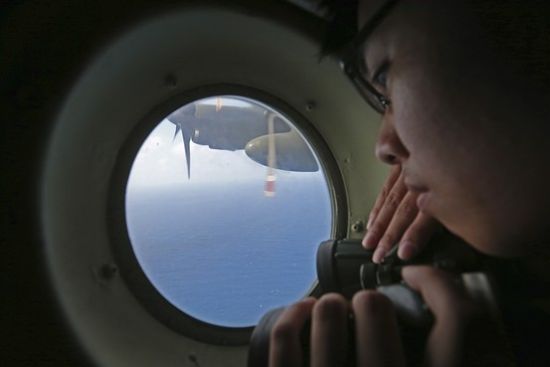双语:美调查称MH370失联后或继续飞四小时
距离马航MH370航班失踪至今已有六天时间,各界关注与日俱增,今天据华尔街日报消息,美国调查员透露根据飞机自身引擎数据回报系统显示,飞机在失联后可能继续飞行近4小时,这则消息引发舆论关注,但目前还未经确认其真实性。新浪教育[微博]结合英文原文,将新闻要点编译如下:
据美国两名调查员透露,根据这架波音777飞机上的引擎自动下载并向地面发送的数据显示,马航失联飞机总共飞行了五个小时。这些数据是飞机例行维护和监控的一部分。据此,美国航空部调查员(Aviation investigators)和国家安全局人员(national security officials)怀疑马航的这架370航班在经过最后得到确认的地点后,仍在空中继续飞行四个小时,如果推测被证实,那么此架飞机极有可能以不明状态多飞行了数百公里。基于飞机的飞行速度并按航线(jet's cruising speed)推测,飞机可能靠近印度洋,甚至到达巴基斯坦和阿拉伯海边界,严重偏离目前搜救范围。
 马来西亚交通部长Hishammuddin Hussein周三在吉隆坡面对媒体作简要搜索信息传达
马来西亚交通部长Hishammuddin Hussein周三在吉隆坡面对媒体作简要搜索信息传达经过六天的搜寻,失联飞机依旧没有被准确定位,甚至出现更多可能性,基于现阶段掌握的信息,各方搜救队伍不得不一再扩大搜索范围(broadening in scope),期待尽早找到失联飞机的踪迹。据一名美国调查员猜测,失联飞机很有可能遭遇机组内部或乘客蓄意关闭无线电设施(jetliner's transponders)躲避雷达搜索(radar detection),然后飞行至一隐秘地点。
 越南海军上尉Le Minh Thanh 在富国岛答记者问
越南海军上尉Le Minh Thanh 在富国岛答记者问虽然如今众说纷纭,并无统一确定的调查结果,这种不排除(ruled it out)各种可能的局势使得各国不断扩大搜寻范围,特别是在得知失联航班有可能继续飞行数小时的消息后,这架重达250吨的飞机从雷达神秘消失的引起越来越多的关注,找到飞机踪迹也显得愈加急迫。
美调查官员称,虽然目前尚不能完全排除恐怖袭击的可能,但是从种种迹象分析,此次马航失联飞机事件应与恐怖袭击关系甚微。
此外,最新消息显示,飞机的发动机数据分析是用以帮助确定飞机的飞行路径,在转发器后停止工作前,该飞机的最后验证位置是在从吉隆坡(Kuala Lumpur)前往中国方向,跨域泰国湾一半的位置上。
以下是来自华尔街日报的英文原文:
U.S. investigators suspect that Malaysia Airlines Flight 370 stayed in the air for about four hours past the time it reached its last confirmed location, according to two people familiar with the details, raising the possibility that the plane could have flown on for hundreds of additional miles under conditions that remain murky. Aviation investigators and national security officials believe the plane flew for a total of five hours based on data automatically downloaded and sent to the ground from the Boeing Co. BA 777's engines as part of a routine maintenance and monitoring program.
That raises a host of new questions and possibilities about what happened aboard the widebody jet carrying 239 people, which vanished from civilian air-traffic control radar over the weekend, about one hour into a flight to Beijing from Kuala Lumpur. Six days after the mysterious disappearance prompted a massive international air and water search that so far hasn't produced any results, the investigation appears to be broadening in scope. U.S. counterterrorism officials are pursuing the possibility that a pilot or someone else on board the plane may have diverted it toward an undisclosed location after intentionally turning off the jetliner's transponders to avoid radar detection, according to one person tracking the probe. More The Tricky Science of Radar Tracking The investigation remains fluid, and it isn't clear whether investigators have evidence indicating possible terrorism or espionage. So far, U.S. national security officials have said that nothing specifically points toward terrorism, though they haven't ruled it out. But the huge uncertainty about where the plane was headed, and why it apparently continued flying so long without working transponders, has raised theories among investigators that the aircraft may have been commandeered for a reason that appears unclear to U.S. authorities. Some of those theories have been laid out to national security officials and senior personnel from various U.S. agencies, according to one person familiar with the matter.
At one briefing, according to this person, officials were told investigators are actively pursuing the notion that the plane was diverted "with the intention of using it later for another purpose." As of Wednesday it remained unclear whether the plane reached an alternate destination or if it ultimately crashed, potentially hundreds of miles from where an international search effort has been focused. In those scenarios, neither mechanical problems, pilot mistakes nor some other type of catastrophic incident caused the 250-ton plane to mysteriously vanish from radar. The latest revelations come as local media reported that Malaysian police visited the home of at least one of the two pilots.
 新加坡飞行军周二在中国南海搜寻马航失联飞机
新加坡飞行军周二在中国南海搜寻马航失联飞机Boeing officials and a Malaysia Airlines official declined to comment. The engines' onboard monitoring system is provided by their manufacturer, Rolls-Royce ,and it periodically sends bursts of data about engine health, operations and aircraft movements to facilities on the ground. Rolls-Royce couldn't immediately be reached for comment. As part of its maintenance agreements, Malaysia Airlines transmits its engine data live to Rolls-Royce for analysis. The system compiles data from inside the 777's two Trent 800 engines and transmits snapshots of performance, as well as the altitude and speed of the jet. Those snippets are compiled and transmitted in 30-minute increments, said one person familiar with the system. According to Rolls-Royce's website, the data is processed automatically "so that subtle changes in condition from one flight to another can be detected."
The engine data is being analyzed to help determine the flight path of the plane after the transponders stopped working. The jet was originally headed for China, and its last verified position was half way across the Gulf of Thailand. A total flight time of five hours after departing Kuala Lumpur means the Boeing 777 could have continued for an additional distance of about 2,200 nautical miles, reaching points as far as the Indian Ocean, the border of Pakistan or even the Arabian Sea, based on the jet's cruising speed. Earlier Wednesday, frustrations over the protracted search for the missing plane mounted as both China and Vietnam vented their anger over what they viewed as poor coordination of the effort. Government conflicts and national arguments over crises are hardly unique to the Flight 370 situation, but some air-safety experts said they couldn't recall another recent instance of governments publicly feuding over search procedures during the early phase of an international investigation.
Authorities radically expanded the size of the search zone Wednesday, which already was proving a challenge to cover effectively, but the mission hadn't turned up much by the end of the fifth day. Also on Wednesday,a Chinese government website posted images from Chinese satellites showing what it said were three large objects floating in an 8-square-mile area off the southern tip of Vietnam. The objects were discovered on Sunday , according to the website, which didn't say whether the objects had been recovered or examined. Ten countries were helping to scour the seas around Malaysia, including China, the U.S. and Vietnam. Taiwanese vessels are expected to be on the scene by Friday, with India and Japan having also agreed to join the search soon.
Aviation experts say the absence of an electronic signal from the plane before it disappeared from radar screens makes it difficult to pin down possible locations. Some radar data suggested the Boeing 777 might have tried to turn back to Kuala Lumpur before contact was lost, a detail that prompted a search for the plane on both sides of the Malaysian peninsula.
(编译:马晴)
- 双语:马航就MH370失联事件媒体声明(十三)2014-03-12 15:23
- 热词:马航MH370飞机失联事件相关词汇2014-03-12 11:08
- 外媒观点:什么原因可能导致马航飞机坠毁2014-03-11 10:31
- 马航上有澳华裔夫妇 引当地华人关注(组图)2014-03-11 10:03
- 马航飞机失踪后续:不排除恐怖袭击(双语)2014-03-10 14:19
- 双语:马航失联飞机与韩亚空难同为波音7772014-03-10 14:17
- 马航失联班机:雷达发现飞行路径曾变(双语)2014-03-10 14:11
- 大马华商乘MH370生死未卜 家人未获马航联系2014-03-10 11:14













閺傜増姘拃锔俱仛閿涙矮鎹㈡担鏇熸暪鐠愬綊顣╁ù瀣兊缁併劋绱伴崨妯肩搼楠炲灝鎲¢惃鍡曡礋鐠囧牓鐛ラ敍宀冾嚞閸曞じ绗傝ぐ鎿勭磼閻愮懓鍤潻娑樺弳鐠囷附鍎�